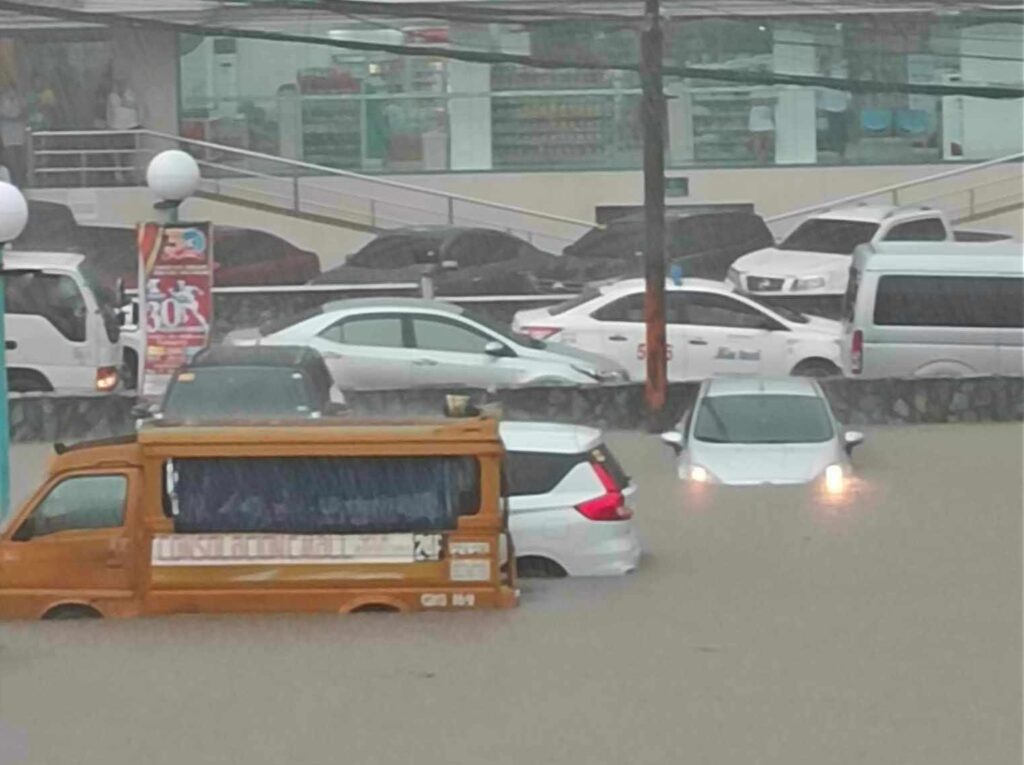
Some vehicles are half submerged in flood waters in a parking lot of an establishment in Barangay Banilad, Cebu City after the heavy rains this afternoon, September 11. | [FILE PHOTO] Contributed photo via Paul Lauro
According to the COA report 2023, the city failed to utilize an amount of P1.456 billion from its LDRRMF capital outlay for the years 2022 and 2023.
This failure, COA says, undermines the fund’s intended purpose of enhancing disaster preparedness and response capabilities.
The LDRRMF Capital Outlay, meant to finance various disaster preparedness and mitigation projects, was allocated P129,353,831.56 in 2022 and an additional P1,455,856,661.59 in 2023.
However, as of the end of 2023, these funds remained largely unspent, with substantial portions of the budgeted projects still pending in various stages of procurement or approval processes.
This non-utilization has effectively rendered the annual investment plans (AIP) ineffective, leaving the city vulnerable to calamities and emergencies.
READ MORE:
COA says Cebu City lacks cash reserves for Singapore-like vision
COA: Cebu City relies on temporary staff amid 2,000 vacant posts
COA flags Cebu City over P114.5M unliquidated funds to NGOs
Legislative framework and fund allocation
Under Section 21 of Republic Act No. 10121, known as the “Philippine Disaster Risk Reduction and Management Act of 2010,” it is mandated that no less than five percent of a local government’s estimated revenue from regular sources be allocated to the LDRRMF.
This fund is intended to support activities such as pre-disaster preparedness programs, purchasing life-saving rescue equipment, and post-disaster recovery initiatives.
In compliance with this law, Cebu City appropriated P2,485,152,373.70 for its LDRRMF in 2023.
READ MORE: COA flags discrepancy in Malabon’s 2023 cash-in-bank account
Delays and procedural bottlenecks
A detailed review of the summary of appropriations, allotments, obligations, and balances (SAAOB) as of December 31, 2023, revealed that the appropriated funds for capital outlays remained unimplemented, amounting to P1,455,856,661.59.
Similar underutilization was noted in the 2022 appropriation.
Discussions with the City LDRRM Office highlighted several factors contributing to these delays, including bureaucratic red tape and procedural bottlenecks.
Many projects were still under procurement processes. For instance, the procurement of multi-tool hydraulic rescue tools and a brand new 4×2 boom truck, each costing millions of pesos, remains in the post-qualification stage as of the latest update.
Additionally, more recent procurement efforts for advanced radar life detectors and a truck-mounted aerial platform, totaling P65,952,000.00, are still awaiting further approvals.
Moreover, an examination of utilization figures over the past five years demonstrated a consistent pattern of low fund utilization.
For example, the capital outlay for 2017 reached full utilization only three years after the budget year, while other years show varying levels of underutilization.
This delayed utilization indicates inefficiencies in the LDRRMO’s procurement and fund management processes, which raises concerns about the city’s ability to respond effectively to disasters and emergencies.
“In summary, the non-implementation of the infrastructure projects under the 20 per cent LDF of CY 2023 boiled down to the absence of judicious and meticulous planning. These funded infrastructure projects, which were mostly for road concreting and drainage systems, could have been greatly beneficial to address issues regarding poor road conditions and flooding, respectively, and hence help improve the living conditions of the constituents,” the report emphasized.
Contributing factors and recommendations
The COA report identified several factors within the city’s management control that contributed to the delays, including complex approval processes, lack of effective inter-departmental coordination, and frequent changes in leadership within the DRRM Office.
For instance, the procurement of goods and services involves multiple steps and approvals from different offices, which can delay project implementation.
With this, the COA recommended that the city revisit and streamline its existing procedures to identify and address bottlenecks.
It also suggested developing a clear strategy to ensure high-level coordination between departments involved in the implementation of disaster-related projects. This strategy should outline specific roles, actions, and conditions that trigger required actions to prevent further delays.
“We reiterated our recommendation that the City refrain from funding projects that are non-procurement/implementation ready, to ensure timely delivery of projects and address the public infrastructure gap,” the report stated.